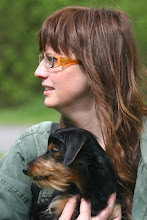 Nang Phan has never seen so many cats in one place.
Nang Phan has never seen so many cats in one place.When I meet a person who is determined to breed their companion animal, I’ll speak until I’m blue in the face trying to talk them out of it. Sometimes I’m successful, other times I’m not. The last words I usually leave them with are, “I wish you could spend one day with me, and see what I see. I’m certain you would change your mind.”
Citizens are consistently stunned when they witness the scope of the overpopulation crisis with their own eyes.
I invite people to join me occasionally for a ride-along when I hit the road to interview animal rescuers. Last week, a friend in town from Toronto named Nang Phan volunteered to join me for the day.
Phan and I made several stops. One of the places we visited always yanks hard at my heartstrings – the Richmond Animal Protection Society’s cat sanctuary in British Columbia, near the Vancouver International Airport. A dedicated group of volunteers and staff led by tireless executive director Carol Reichert pour every spare minute they have into caring for more than 800 cats unwanted by society.
Carol, a retired Canadian Airlines flight attendant, started her career in animal rescue in the late 1980s by feeding stray kittens in the airport employee parking lot. Soon she was trapping and feeding throughout Richmond. She and her volunteers prowled the streets late at night following the nocturnal schedule of the cats. But her good work wasn’t always appreciated. Eventually the safety of her feeders and the cats was threatened by residents and business owners who didn't want the animals to survive. Carol gathered up the cats and settled them on six acres of farmland near the airport.
Whenever I visit there, I only have to enter the gate for the voice track in my mind to start a drumbeat in my ears – “spay and neuter, spay and neuter, spay and neuter…” Those three words echo as I wander the grounds. Cats run to greet me from all directions, coming up to say hello in their own special way.
Every community struggles with companion animal overpopulation, but the plight for cats is always more dire than that facing dogs. Cats are allowed to wander freely without regard for their safety. And when they inevitably get lost, people don’t come looking – cats are redeemed far less often. People don’t fix them, license them, or arm them with identification. Guardians often move away and leave their cats behind, assuming erroneously that they will survive. I find these skinny, abandoned creatures sitting on windowsills, looking sadly into the empty houses that were once their homes.
If the cats do manage to survive, they procreate unaltered, adding exponentially to the overpopulation crisis. A common statistic bandied about by rescuers goes like this: in seven years, an unaltered male and female cat can produce 470,000 cats, which includes their babies and their cats’ babies. Due to the harsh conditions they face, 90 percent will die in the wild.
Phan says her day with the animals was an experience she’ll never forget. “I saw a lot of people with compassion there. Carol is definitely a trooper. There was a time when I stood there and all the cats gathered around me. That was an eye-opener for me personally.”
It’s an experience I wish I could impart to everyone.









No comments:
Post a Comment